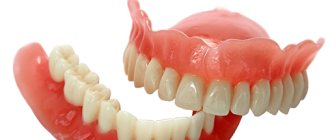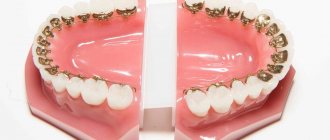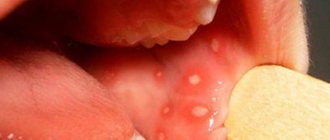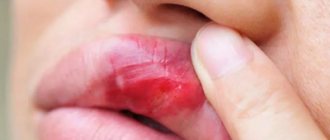Food allergy is one of the most common allergic conditions that develops due to intolerance to certain compounds in certain foods. In recent decades, doctors have noted an increase in the incidence of hypersensitivity to food, which is especially noticeable among the population of developed countries. This may be due to the variety of substances found in them. About half of people suffering from food allergies are children under 12 years of age, but the frequency of manifestations is already significantly increasing among adults.
Sensitization to allergens from food has a hereditary predisposition - many researchers talk about this. For example, Karataeva and Yusupova point out that “approximately half of patients suffering from food allergies have a burdened family or personal allergic history, i.e. either they themselves suffer from some allergic diseases (hay fever, atopic bronchial asthma), or these their closest relatives suffer from diseases” (Karataeva N.A., Karataeva L.A., Yusupova O.I., Inoyatova Sh.K., 2015, p. 128).
Causes of food allergies
There are several mechanisms for the development of allergies. But a significant proportion of cases are associated with type 1 hypersensitivity. It is explained by the release of immunoglobulin IgE and the activation of basophils. This reaction occurs in response to the entry into the digestive system of protein compounds recognized by immune cells.
Some predisposing factors are unique to children, others are also found in adults. Among the most common reasons are the following:
- Features of allergens in food. The reaction is most often provoked by antigens with high immunogenicity. They easily overcome the aggressive environment of the stomach. They are found in large quantities in whole milk, fish, eggs, cereals, strawberries, citrus fruits, and nuts.
- Hereditary predisposition. Food allergies are associated with hereditary characteristics of the body. They manifest themselves by increased reactivity, disruptions in the functioning of the immune system, as well as other mechanisms.
- Age-related features of the development of the digestive system. Children have high permeability of the stomach walls, and the acidity of gastric juice is lower than in adults. The composition of the microflora is also different. All this creates favorable conditions for the allergen to come into contact with immune cells.
The condition may be associated with the amount of food eaten and the characteristics of culinary processing. There are cases of so-called cross-allergy to pollen and household dust: some food products with similar compounds in their composition trigger an allergic reaction.
According to many researchers, the formation of allergies is facilitated by dietary violations during pregnancy, as well as early transfer of the child to artificial feeding. Gastrointestinal diseases, especially diseases of the liver, gallbladder, and biliary tract, also trigger and contribute to the exacerbation of allergies.
Causes of allergies
There are, in fact, as many allergens as there are substances and compounds known to man. In other words, the cause of an allergic reaction on the eyeball (conjunctiva) and the skin around the eyes can be anything: plant pollen, any food, household chemicals, animal hair, bird down and feathers, house dust (infested with microscopic mites), insect bites, hygiene and cosmetic products, medicines, sweat, saliva or hair of other people, etc., etc. At the same time, to this day the etiopathogenetic mechanism, which in one person “triggers” an individual violent (in some cases catastrophic) reaction to any substance, has not been thoroughly clarified, while the body of another person remains completely indifferent to the same substance. However, the role of congenital predisposition, as well as the cumulative (cumulative) nature of the allergenic effect, has been reliably established.
Foods and additives that cause allergies
Doctors Sidorovich and Luss write that “almost any food product can act as an allergen and cause the development of food allergies. However, the most pronounced sensitizing properties are in products of protein origin containing animal and vegetable proteins” (Sidorovich O. I., Luss L. V., 2021, p. 141). The table shows the most common allergens in food:
| Plant food | Raspberries, strawberries, wild strawberries, black currants, blackberries, pineapple, melon, persimmon, pomegranate, citrus fruits, chocolate, tomatoes, nuts, honey, mushrooms, wheat, soybeans, carrots |
| Animal food | Milk, eggs, fish, crustaceans and seafood, cold processed chicken |
| Supplements | Pesticide residues and agricultural fertilizers in plant foods. Dyes (especially tartrazine, erythrosine, sodium nitrite), flavorings (glutamates), preservatives (benzoates, benzoic acid, sulfites), enzymes, thickeners, emulsifiers, bacteriostatics, flavor enhancers (monosodium glutamate), etc. |
Note that allergen additives provoke so-called false reactions, or pseudo-allergies. In this case, food antigens can act without the participation of allergic antibodies on target cells or activate certain biological systems; they are not based on immune reactions.
An increase in the level of histamine in the blood may not be associated with a true allergy, but with the consumption of foods containing it in large quantities: fermented cheeses, sauerkraut, dried ham, canned food, spinach.
Symptoms of the disease
Food allergies often appear within a few minutes of consuming the product. There is a rash, itching, redness, swelling of the skin of the hands, face and neck. Many people complain of a sore throat, heartburn, and bloating. Children and adolescents are at high risk of anaphylactic shock, acute urticaria, eczema, and asthma.
In adults, the following symptoms most often develop:
- chronic urticaria;
- atopic dermatitis;
- rhinitis and conjunctivitis;
- gastritis;
- migraine;
- dermatitis.
According to statistics, skin manifestations are observed much more often. The rash is usually erythematous in nature. Elements of the rash can be located on any part of the skin. Dermatological manifestations persist from several hours to several days, then disappear on their own provided there is no further contact with the allergen.
When it enters the body again, the allergy develops again. There is a possibility that each episode will be more severe and intense.
Food allergies cause gastrointestinal problems within the first hours. The following symptoms are usually noted:
- stool disorders;
- abdominal pain, bloating;
- vomiting
With high allergic readiness, these symptoms develop already at the time of consumption of the allergen. It happens that dyspepsia is accompanied by immediate swelling of the mucous membranes of the mouth, lips, and tongue; nasal congestion.
Some varieties of fish, strawberries, and peanuts cause the most severe systemic reactions - angioedema, anaphylactic shock.
People suffering from bronchial asthma or food allergies often experience an attack that develops as a cross-allergy. Headaches, fatigue, and weakness appear after eating potentially dangerous foods.
Quincke's edema
Swelling of the lips is the first symptom of Quincke's edema. It is also called giant urticaria and is an acute allergic reaction.
The peculiarity of this phenomenon is the rapid increase in symptoms. If your lips are sharply swollen, have doubled in size or more, and there are other signs of giant urticaria, you should call an ambulance.
Signs of this disorder include:
- swelling of the lips, tongue, larynx;
- skin hyperemia;
- small rash around the swollen area;
- headache;
- nausea and vomiting;
- dyspnea;
- tachycardia;
- general malaise.
Any allergen can cause giant urticaria. The most common causes are pollen, animal dander, chemicals, and medications. Giant urticaria occurs from insect bites. According to statistics, children encounter this immunopathological process more often than adults (8% of cases versus 2%).
There are also hereditary forms of angioedema associated with congenital pathologies of the thyroid gland, liver or immune system.
First aid
If a person’s eyes and lips are suddenly swollen, he should:
- Apply a cold compress to the affected area.
- Take a tablet of any antihistamine.
- Drink plenty of fluids.
- Call an ambulance.
Before the medical team arrives, you are allowed to drink a soda solution (1 g of soda per 1 liter of water). This reduces the rate of spread of the pathological process to the respiratory system.
Drug treatment includes the administration of corticosteroids, diuretics, and immunomodulatory therapy. The treatment regimen is determined by the doctor. In some cases, emergency hospitalization is necessary.
Diarrhea due to food allergies
Researcher Kozyarin points out the high probability of diarrhea with food allergies: “If a person is not treated, then he may experience inflammation of the stomach and small intestine with abdominal pain and constant stool upset” (Kozyarin N.P., 2009, p. 66).
Allergies disrupt the frequency of bowel movements, with diarrhea observed for several days, which is often followed by constipation. This is not harmless, especially for people who already have intestinal problems.
Damage to the walls of the intestines and stomach leads to disruption of the processes of digestion and absorption of nutrients. If measures are not taken in a timely manner, thickening of the walls, a decrease in the intestinal lumen, and serious consequences in the form of persistent stool disorders and abdominal pain are possible.
An allergic reaction disrupts the balance of intestinal microflora . The mechanisms of influence of allergic processes on digestion are so diverse that independent gastroenterological diseases often develop, such as gastritis, peptic ulcers, and enzymatic deficiency in children. At the same time, treatment of these pathologies by a specialized specialist without adjusting the diet and taking measures to eliminate allergies is not always successful.
Diarrhea due to allergies can independently lead to complications - proctological pathologies, water-salt imbalance, and dehydration. Therefore, it is important to resort to symptomatic therapy before basic measures take effect.
Why do eyes suffer from allergies?
The eyes are among the “favorite targets” and areas for the development of allergic reactions. The tissues and structures of the eyeball are thin, very sensitive, not very well protected from the harmful influences of the external environment - and therefore especially vulnerable. The cornea, eyelids, eyelashes, sclera, conjunctiva are in direct contact with the air, where particles of countless substances are contained in suspension, as well as with rain and tap water, with cosmetics, shampoos, creams, eye drops and gels, and contact lenses. In addition, in close proximity and in direct communication with the orbit there are many other equally vulnerable mucous membranes (nose, oral cavity, etc.). The eyes are also susceptible to allergic reactions to substances that enter the body, for example, to individually allergenic foods and medications.
Complications
The most severe complication from strong food allergens is anaphylactic shock. It develops due to hypersensitivity to certain foods or ignoring the first signs for a long time. The entry of an allergen into the human body leads to increased symptoms and further development of shock. The authors Pampura and Khavkin come to the conclusion that “in some patients, anaphylaxis appears only if physical activity is preceded by the consumption of a certain product” (Pampura A.N., Khavkin A.I., 2003, p. 1126).
If the allergy is manifested by vomiting and diarrhea, then prolonged contact with the allergen leads to electrolyte disturbances. They, in turn, often require correction in a hospital setting and also threaten human life and health.
Other complications include the addition of a bacterial infection when scratching the skin, the formation of cross-allergy to pollen or household dust.
First aid for food allergies
They independently provide first aid for allergies to food additives, if the person’s life and health are not in danger.
What symptoms indicate a direct threat:
- breathing problems;
- swelling of the neck, tongue;
- altered speech;
- confusion.
All of the above is a reason to call an ambulance . If an allergic reaction appears for the first time, even without symptoms that threaten health, it is necessary to get medical help as soon as possible, especially if we are talking about a child.
If symptoms are not expressed, it is permissible to take the first measures yourself. The following categories of drugs are used for this:
- Sorbents. They allow you to bind and remove harmful substances from the gastrointestinal tract. Such drugs accelerate the elimination (removal) of allergens, alleviate the condition and speed up recovery.
An effective product from this group is Fitomucil Sorbent Forte, which contains the shell of psyllium seeds, as well as the prebiotic inulin and a complex of live probiotic bacteria. Psyllium seed husk is a natural soluble fiber that absorbs water and allergens into a mucilaginous gel. The drug does not irritate the intestinal walls, gently stops diarrhea, promoting thickening of stool.
- Antihistamines. Today there is a wide range of new generation medications that do not have side effects such as drowsiness and are well tolerated. It is better to choose medications from those you have already taken before, or consult a doctor.
For skin manifestations, it is possible to use local agents with antihistamine and soothing, antipruritic effects. Severe allergies, manifested by severe redness and itching of the skin, will most likely require the use of local hormonal ointments and creams.
But remember that they are prescription drugs and cannot be used for longer than the time prescribed by the doctor - usually about 7-10 days for mild to moderate cases. Hormonal drugs for oral administration or injection also require a prescription from a specialist who will develop a suitable regimen for use.
Developed vomiting and diarrhea require action. Taking sorbents will help in the second case, and in case of uncontrollable vomiting, you should seek emergency help. If vomiting and diarrhea occur sporadically, several times a day, it is necessary to replenish fluid loss with the help of special rehydration solutions - pharmacy or self-prepared.
It is necessary to drink enough fluids to prevent dehydration and the occurrence of associated disorders. Kozyarin suggests using herbal tea, decoctions of plants: “chamomile, St. John’s wort, calendula, calamus, valerian” (Kozyarin N.P., 2009, p. 66).
Treatment of eye allergies
A characteristic feature of any allergic reaction is that in the absence of the allergen, the symptoms disappear without a trace. Accordingly, the ideal treatment method is the complete elimination of the allergenic factor from the patient’s living space, or the isolation of the patient from such factors (in some cases, the optimal solution is, for example, moving to another region or a dramatic separation from a furry pet).
Otherwise, both systemic and local antiallergic therapy is prescribed, which, like any other drug treatment, has significant drawbacks and pitfalls. For example, a number of drugs with this effect (especially previous pharmacological generations) negatively affect concentration and/or cause drowsiness; the effectiveness of treatment may decrease over time due to the addictive effect; with the accumulation of the active substance, in some cases the body may react to the components of the medicine itself as an allergen, etc. Therefore, any self-diagnosis and self-medication in this case are strictly contraindicated: antiallergic therapy is prescribed (based on the results of confirmatory diagnostics) and monitored only by a specialist in the appropriate field.
Antihistamines
The substance that is a mediator and regulator of immune allergic reactions in the body is called histamine. Accordingly, the action of the “antihistamines” known to many is based on the inhibition (suppression, suppression) of the specific activity of histamine-sensitive cells, or h1- and h2-receptors. Antihistamines for ophthalmic use come in a variety of forms, but are usually tablets or eye drops:
- Aktipol
- Allergodil
- Lecrolin
- Cromohexal
- Opatanol
- Spersallerg et al.
Hormonal agents in the treatment of allergies
Corticosteroid or non-steroidal drugs may be prescribed to relieve inflammatory symptoms and reduce swelling.
Corticosteroids are usually used in the form of eye drops, ointments or gels as adjunctive therapy, especially for chronic inflammation of allergic origin. The most common medications are hydrocortisone eye ointment, Dexamethasone and Prenacid eye drops. However, drugs in this group are considered unsafe and in no case should the patient be taken arbitrarily, on his own initiative: a side effect of uncontrolled use can be a persistent increase in IOP (intraocular pressure), excessive suppression of local immunity and other quite serious negative consequences.
NSAIDs (non-steroidal anti-inflammatory drugs)
Non-steroidal anti-inflammatory drugs are prescribed, as a rule, as part of combination therapy for severe seasonal catarrh, conjunctivitis, and uveitis. These include drops:
- Diclofenac
- Indocollier
- Diklof and Naklof
- Bronsiak
To eliminate swelling and hyperemia (redness) of the mucous membranes of the eyelids and skin of the eyelids, vasoconstrictor medications may be prescribed, but it should be understood that such drugs are not an etiopathogenetic treatment of allergies themselves.
If you have problems with your eye reaction to contact lenses, you should immediately stop wearing them until you consult with your supervising ophthalmologist. In any case, all rules and instructions for the safe and hygienic use, storage and care of lenses must be strictly followed.
Treatment
The course of treatment can be divided into two parts: the use of medications when symptoms immediately appear and therapy aimed at prevention. Doctor Luss o (Luss L.V., 2005, p. 140).
Antihistamines are not a panacea, since both with true allergies and with pseudo-allergies, it is important to promptly eliminate risk factors for the development of severe manifestations.
The main ones include concomitant diseases of the gastrointestinal tract, leading to failure of the digestion process, changes in the permeability of the walls of the gastrointestinal tract, and a decrease in the acidity of gastric juice. For this purpose, enzyme preparations, enterosorbents, and probiotics are used.
The most important point after the first measures is to accelerate the elimination of the allergen and prevent further contact with it. The main stages of treatment look like this:
- Symptomatic therapy: taking antihistamines for first aid.
- Elimination of the allergen from the body: prescribing a hypoallergenic diet, pharmacological methods, or a combination of these approaches. If the “provocateur” entered the digestive system recently (several hours ago), enterosorbents will be especially effective. They bind substances in the intestinal lumen, preventing them from further entering the bloodstream. If allergens have been in the body for a long time or a lot of time has passed after a single exposure, elimination occurs naturally, and sorbents will only help in eliminating symptoms.
- Allergen-specific immunotherapy (ASIT). This stage follows only after elimination, comprehensive diagnosis, and accurate identification of the provoking antigen.
ASIT is relevant when irreplaceable dishes are added to the list of those prohibited for consumption; the human body is not provided with everything necessary. This method consists of introducing certain dosages of the allergen, which are gradually increased, which allows the development of immunological tolerance.
Author Luss emphasizes that “the attitude towards ASIT in patients with IPA is not yet clear and contradictory. Basically, preference is given to prescribing elimination diets” (Luss L.V., 2005, p. 140). Perhaps this is due to the need to undergo comprehensive diagnostics and constant long-term treatment when the allergy no longer manifests itself. After all, ASIT can be recommended six months after changing the diet. However, this method is the only option to get everything you need from food when you have allergies.
Nutrition for food allergies
The complex of therapeutic measures necessarily includes a nutritional method. Eliminating the cause—the antigen—is extremely important to improve the condition and prevent exacerbations. A complete avoidance of intolerant foods is expected. For convenience, we have provided a list of permitted and prohibited items in the table:
| Allowed | Prohibited |
| Unfortunate bread | Smoked meats |
| Tea | Vinegar |
| Sugar | Fish |
| Boiled lean beef | Mushrooms |
| Butter and vegetable oils | Bird |
| Fresh cucumbers | Nuts |
| Parsley dill | Whole cow's milk |
| Watermelons | Honey |
| Baked apples | Nuts |
| One-day fermented milk products | Fruits and berries: strawberries, melon, pineapple, citrus fruits |
| Cereals: rice, buckwheat, oatmeal | Vegetables: eggplant, radish, horseradish |
Fasting is strictly prohibited for people with chronic diseases, blood diseases, malignant neoplasms, sore throat, other respiratory diseases, liver and circulatory diseases in history.
You will need to limit or eliminate ready-to-eat cereals, pasta (without eggs), ready-made pies, gingerbread cookies, colored marshmallows, and caramels due to the tartrazine they contain. It is necessary to limit the consumption of wine, beer, fruit juices, gelatin, baking mixes, marinades, and most prepared sauces, as they contain sulfites.
There are different options for therapeutic nutrition:
- Grain-free diet. Involves avoiding cereals, flour products, seasonings, and sauces. Preference is given to meat, vegetables, fruits, and dairy products.
- Egg-free diet. Excludes eggs, seasonings, mayonnaise, sauces and creams, pasta, baked goods containing eggs. The diet consists of meat, dairy products, cereals, vegetables, and fruits.
- Dairy-free diet. Milk, milk porridge, cottage cheese, confectionery, and butter are excluded from the diet. The menu is based on dishes of meat, fish, eggs, cereals, vegetables and fruits.
- Diet excluding milk, cereals, eggs.
Thus, it is not necessary to give up all possible allergens. When you consult a doctor, you will receive accurate recommendations. It is important to make your own assumptions about what exactly could have been the source of unpleasant manifestations.
Keeping a diary will help determine which food allergens could cause a response and which ones are not perceived aggressively by the body. At the same time, you should write down not only everything you eat during the day, but also the cooking methods. Note exactly what manifestations of allergies are observed: skin itching, stool disorders, redness of the skin, nausea.
The main feature of nutrition for allergies is not simply to refuse a certain food, but to find an adequate replacement. The diet must remain balanced, otherwise severe restrictions are likely to lead to vitamin and mineral deficiencies. If you are forced to completely give up milk and eggs, your diet should include a variety of meat and fish dishes. It is better to search for alternatives together with your doctor.









